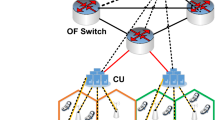Abstract
A multi-cluster, multi-hop packet radio network architecture for wireless adaptive mobile information systems is presented. The proposed network supports multimedia traffic and relies on both time division and code division access schemes. This radio network is not supported by a wired infrastructure as conventional cellular systems are. Thus, it can be instantly deployed in areas with no infrastructure at all. By using a distributed clustering algorithm, nodes are organized into clusters. The clusterheads act as local coordinators to resolve channel scheduling, perform power measurement/control, maintain time division frame synchronization, and enhance the spatial reuse of time slots and codes. Moreover, to guarantee bandwidth for real time traffic, the architecture supports virtual circuits and allocates bandwidth to circuits at call setup time. The network is scalable to large numbers of nodes, and can handle mobility. Simulation experiments evaluate the performance of the proposed scheme in static and mobile environments.
Similar content being viewed by others
References
K.S. Gilhousen, I.M. Jacobs et al., On the capacity of a cellular CDMA system, IEEE Trans. Veh. Tech. 40 (1991) 303–312.
P. Jung, P.W. Baier and A. Steil, Advantages of CDMA and spread spectrum techniques over FDMA and TDMA in cellular mobile radio applications, IEEE Trans. Veh. Tech. 42 (1993) 357–364.
J. Jubin and J. D. Tornow, The DARPA packet radio network protocols, Proc. IEEE 75 (1987) 21–32.
D.J. Baker, A. Ephremides and J.A. Flynn, The design and simulation of a mobile radio network with distributed control, IEEE JSAC, SAC-2 (1984) 226–237.
A. Ephremides, J.E. Wieselthier and D.J. Baker, A design concept for reliable mobile radio networks with frequency hopping signaling, Proc. IEEE 75 (1987) 56–73.
A.K. Parekh, Selecting routers in ad-hoc wireless networks,ITS (1994).
N. Bambos and G.J. Pottie, On power control in high capacity cellular radio networks, IEEE GLOBECOM 2 (1992) 863–867.
Y. Ofek, Generating a fault tolerant global clock using high-speed control signals for the MetaNet architecture, IEEE Trans. Commun. 42 (1994) 2179–88.
S.C. Chen, N. Bambos and G. Pottie, Admission control schemes for wireless communication networks with adjustable transmitter powers. IEEE INFOCOM 1 (1994) 21–28.
N. Bambos, S. Chen and G. Pottie, Radio link admission algorithms for wireless networks with power control and active link quality protection, Technical Report UCLA-ENG-94-25, UCLA, School of Engineering and Applied Science (1994).
M.S. Corson and A. Ephremides, A distributed routing algorithm for mobile wireless networks, Wireless Networks 1 (1995) 61–81.
D.J. Goodman and S.X. Wei, Efficiency of packet reservation multiple access, IEEE Trans. Veh. Tech. 40 (1991) 170–176.
R.W. Muise et al., Digital communication experiments in wide bandwidth packet technology,1986 International Zurich Seminar on Data Communications, ed. A. Kundig (1986) pp. 11–13.
F. Kamoun, design considerations for large computer communications networks, Technical Report UCLA-ENG-7642, UCLA, School and Engineering and Applied Science (1976).
Y. Rekhter, S. Hotz and D. Estrin, Constraints on forming clusters with link-state hop-by-hop routing, Technical Report USC-CS-93-536, University of Southern California (1993).
R.L. Bagrodia and W.-T. Liao, Maisie: a language for the design of efficient discrete-event simulations, IEEE Trans. on Software Eng. 20 (1994) 225–38.
L. Kleinrock and J. Silvester, Spatial reuse in multihop packet radio networks, Proc. IEEE 75 (1987) 156–167.
Author information
Authors and Affiliations
Additional information
This work was supported by the U.S. Department of Justice/Federal Bureau of Investigation, ARPA/CSTO under Contract J-FBI-93-112 Computer Aided Design of High Performance Wireless Networked Systems.
Rights and permissions
About this article
Cite this article
Gerla, M., Tzu-Chieh Tsai, J. Multicluster, mobile, multimedia radio network. Wireless Netw 1, 255–265 (1995). https://doi.org/10.1007/BF01200845
Issue Date:
DOI: https://doi.org/10.1007/BF01200845




